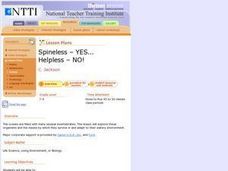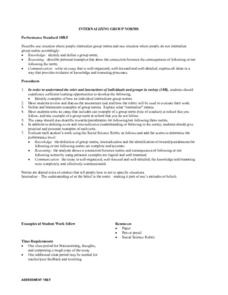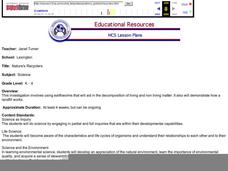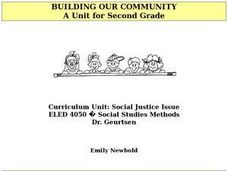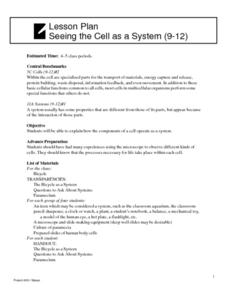Curated OER
Food Chains and Food Webs
Young scholars discuss the characteristics of producers, consumers and decomposers. Using a flow chart, they construct a food chain to visually show how organisms with different energy sources depend upon one another. Students explore...
Curated OER
Finding Caterpillars
Students examine how animals protect themselves from predators and camouflage themselves. They participate in a simulation in which they locate red and green yarn "caterpillars," organize their data, and generate a bar graph using...
Curated OER
Earthworm Bridge
Fourth graders complete analysis experiments for decomposers and their adaptable traits. In this decomposers lesson, 4th graders test worm behavior to light, sound, warmth, touch, and moisture. Students work in groups to analyze the...
Curated OER
Spineless - YES... Helpless - NO!
Students distinguish between invertebrate and vertebrate organisms while examining the zoological classes of a number of invertebrates. They illustrate a food web of these organisms and investigate the impact of humans on the oceanic...
Curated OER
Bottled Model Lungs
Students will learn about the respiratory system by comparing and contrasting models, building their own models, and giving one another feedback. Questions about familiar body systems can be useful in getting students to start thinking...
Curated OER
Citizen Me
Fifth graders examine what it means to be a citizen. Using the Constitution, they discover the functions and purpose of government. They compare and contrast the difference between a democracy and a monarchy. As a class, they discuss...
Curated OER
Internalizing Group Norms
Students consider how to internalize group norms. They descirbe a situation where people internalize group norms and a situation where people do not internalize group norms. They brainstorm examples of group norms and define...
Curated OER
Wild Animal Science
Students discover how environmental factors impact the survival of a population. For this landscape design lesson, students create a new animal and discuss the relationship between the animal and its environment before creating a habitat...
Curated OER
Nature's Recyclers
Learners create environments to demonstrate how earthworms interact with their surroundings.
Curated OER
Plants of the Past
Fourth graders explore ecosystems by examining plants of the past. They discuss ways in which we interact with plants in our daily lives. Students discuss the role plants play in providing food for animals and the significance they had...
Curated OER
Grand Grocery Graphs
Learners experience creating their own graphs on graph paper and the computer program "Graph Club." They approach this task by utilizing food as their primary source for the activities. In addition, they interact with their peers as they...
Curated OER
Country Research
Sixth graders research a given country using teacher selected websites. They gather notes about their country in an organized manner. They then create a PowerPoint including a reference page displaying the information they gathered.
Curated OER
Cell Organelles
Learners explore biology by researching living cells. In this living organism lesson, students participate in a role-playing activity in which all the learners in class form one plant cell by portraying specific parts of a cell. Students...
Curated OER
Five Themes of Geography
Young scholars explore the five themes of geography: place, region, interaction, location and movement. They create a Powerpoint presentation with separate slides for each of the themes.
Curated OER
Timeline - United States and Germany, Before, During, and After World War II
Students read novel Rosa's Miracle Mouse, research assigned years in small groups, and create timelines and Powerpoint presentations detailing interaction between Germany and the United States before, during, and after World War II.
Curated OER
EE*Pro App
Scholars investigate EE*Pro App. In this secondary mathematics lesson, let your class explore an all-inclusive App for electrical engineering students. The App is organized into analysis, equations, and references.
Curated OER
ME*Pro App
For this secondary mathematics lesson, learners investigate the uses and capabilities of a TI-89 application designed for mechanical engineering learners. The app contains over 700 pieces of reference information and organized into...
Curated OER
Animal Masks
Learners design and make animal masks. In this research and application lesson, students use a computer to research what a panther eats, select an animal mask they want to make and then use the materials provided to create their...
Curated OER
Catalase Enzyme
Pupils design and conduct an experiment to test their ideas about how to speed up or slow down the rate of an enzyme-catalyzed reaction. They have access to an array of physical and chemical factors that might influence enzyme activity....
Curated OER
Changing the World: Social Entrepreneurs Part One
Students analyze the purpose of a social entrepreneur. In this entrepreneurship lesson, students create a "help wanted" advertisement and graphic organizer to provide information on how a social entrepreneur seeks long-term change by...
Curated OER
Lost Worlds
Students, while using the strategy of identifying the main idea and supporting details, explore the three nonfiction selections of the lost worlds of Machu Picchu high in the Andes Mountains, Great Zimbabwe, and Anasazi. In addition,...
Curated OER
Virtual Reality Construction Project
Students utilize the technology of virtual reality in order to perform a construction project. The construction has to do with the making of a reality scene using special Apple Virtual Reality software.
Curated OER
Building Our Community
Second graders examine the different relationships within communities. They discover the need for rules and organization. They identify their role in the local community as well.
Curated OER
Seeing the Cell as a System
Students explain how the components of a cell operate as a system. Students examine a bicycle and find out if parts were arranged differently, could the system still be carried out. They look at cells as well and see what function they...





